Our main research topics are in: observational cosmology and large scale structure ; galaxy evolution and active galactic nuclei ; pulsars and compact objects ; stellar astrophysics and asteroseismology. We also have a small, but growing involvement in using data sonification of astronomical data. We have research ties with the other groups in the school, including theoretical cosmology through testing cosmological models and alternative theories of gravity. Also we have ties with the astrophysical fluids group, in particular in the study of the interstellar medium of galaxies. We also have research collaborations with Newcastle University’s School of Computing, specifically in applying machine learning to solving astrophysical and cosmological problems.
Pulsars and Compact Objects
Transitional Millisecond Pulsars
Pulsars are born spinning rapidly but their strong magnetic fields produce strong winds that carry away their kinetic energy so that pulsars generally disappear after a few million years. But some pulsars are observed with spin periods of milliseconds and have weak magnetic fields so that they can last for billions of years. Many of these millisecond pulsars are in binary systems with close companions. It has been understood for years that millisecond pulsars form in a process of “recycling”, where accretion from a companion spins the pulsar up to millisecond periods. In fact we observe neutron stars in low-mass X-ray binary systems where this appears to be occurring. The end of accretion – its causes, its mechanism, and how it avoids spinning the pulsar back down – has remained mysterious.
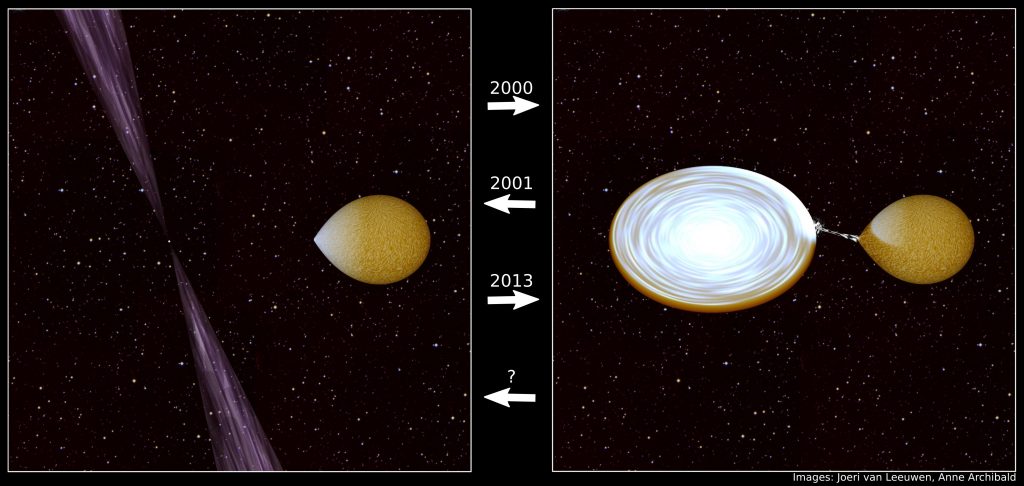
In 2009, the first of a new category of pulsars was found: PSR J1023+0038 transitions between a radio millisecond pulsar state, where no accretion disc is evident, and a state that is brighter in optical, X-rays, and gamma rays. Two other such objects have since been found, and more candidates have been put forward in the literature. Observing these objects and their transitions promises to reveal the physics of low-level accretion and allow the tools of pulsar timing to be applied to accreting systems.
Pulsar timing
Although pulsars are exotic and complicated objects, the pulses we observe from them are primarily recording their rotation, and this rotation can be remarkably stable, close to the stability of terrestrial atomic clocks. These pulsations can reveal the torques acting on the neutron star in PSR J1023+0038, or their arrival times can probe the space between the pulsar and our telescopes. This can reveal the erratic binary orbit of PSR J1023+0038, or it can provide precision measurements of the orbit of the triple system PSR J0337+1715.
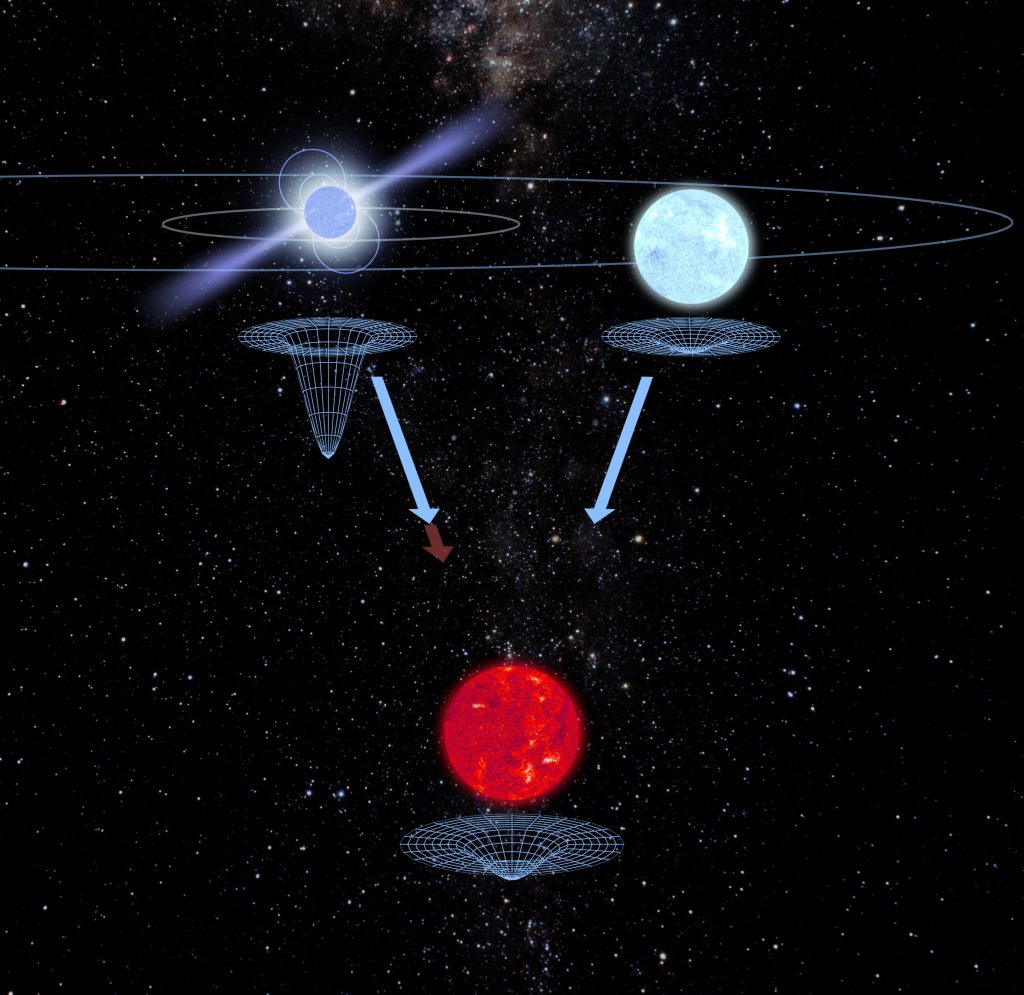
In addition to the study of individual pulsars and their orbit, precision timing of millisecond pulsars offers the possibility that we might detect the contraction and expansion of the space around the Earth due to gravitational waves on a much larger scale than LIGO or LISA can detect. We are involved in the NANOGrav team’s efforts to do this, and their results are hinting at a possible detection of gravitational waves that probe the formation history of galaxies.
Fast radio bursts
Pulsars are normally found by means of the periodicity in their pulses. But we have learned that some pulsars are not detected on every pulse, or are so slow it’s more efficient to search for single pulses from them. So pulsar surveys were scanning the sky searching for bright short radio flashes when the Lorimer burst was detected – a radio burst only milliseconds long that came from somewhere outside our Galaxy. We have now identified these extragalactic radio flashes as a relatively numerous kind of source, a few of which produce repeated bursts from the same location. The mechanism which produces these bursts must be an extremely intense coherent process but we are examining their radio signals in detail to try to understand the mechanism and environment that give rise to them. We are associated with the Amsterdam group studying fast radio bursts and the ASTROFLASH project.
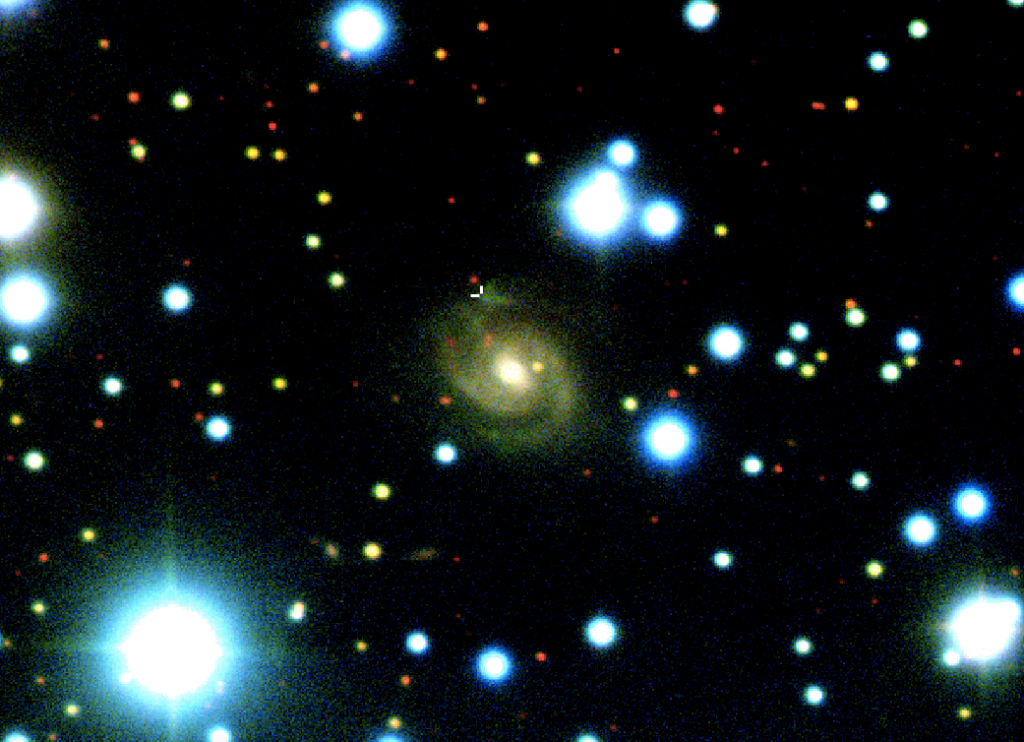
Galaxy Evolution and Active Galactic Nuclei
The Impact of Supermassive Black Hole Growth on Star Formation
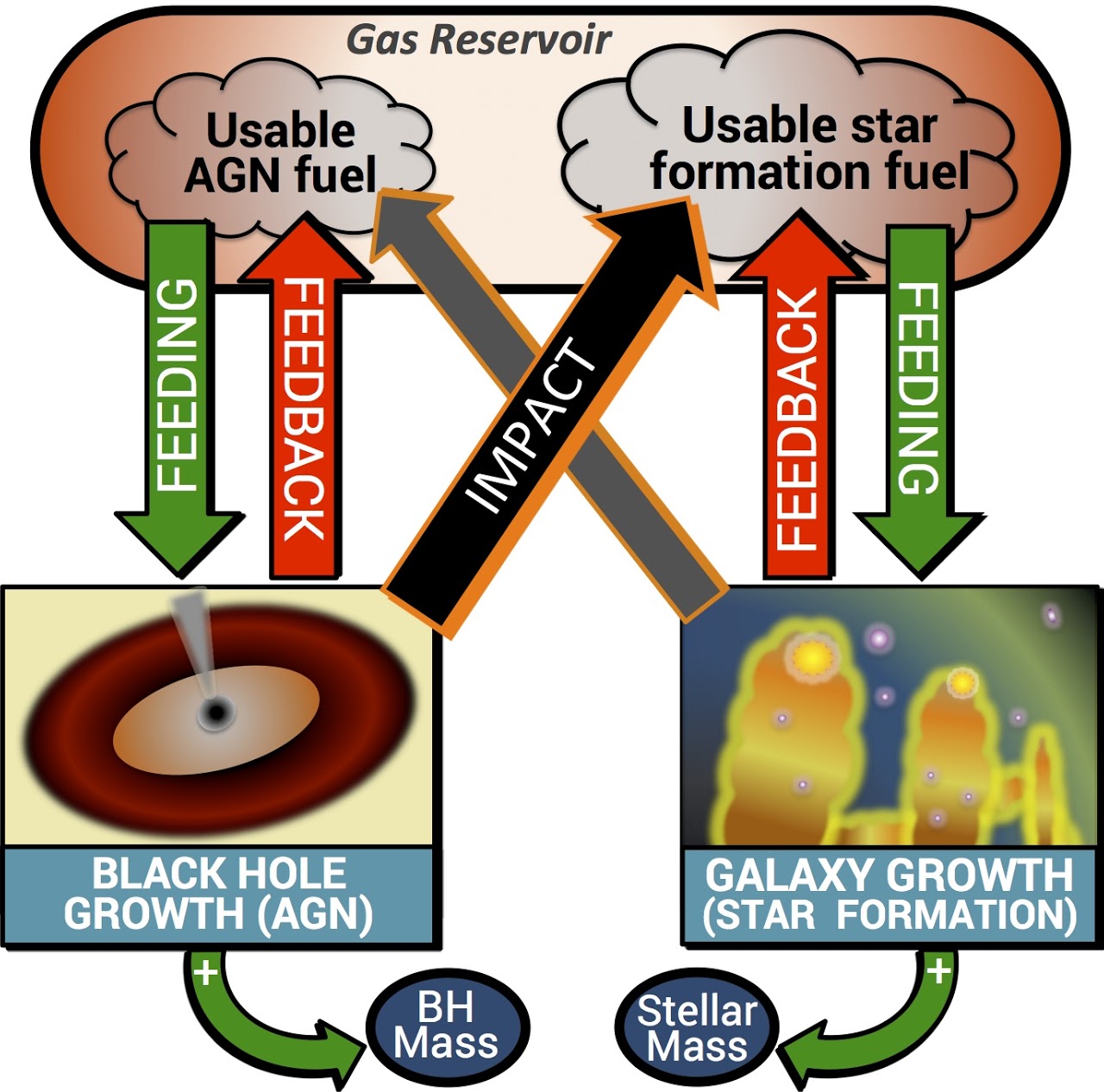
Both black hole growth (AGN) and star formation are fuelled by cold gas that originates from a shared (potentially hot) gas reservoir inside the galaxy halo. The amount of gas and the ability for this gas to cool determines the amount of usable fuel that can be used for feeding black hole growth and star formation. Both processes are also known to inject energy and momentum (via radiation, winds and jets) that can reduce the availability of usable fuel through ionising, heating, shocking or expelling material, and hence provide self-regulatory feedback mechanisms. A key component of most galaxy formation models is that these two processes can also have a positive or negative impact on the usable fuel supply for the other process (black and grey arrows).
Our group uses multi-wavelength observations (e.g., KMOS, SINFONI, ALMA, Herschel, Chandra) and results from cosmological simulations to characterises the relationship between star formation and black hole growth – a crucial test of our understanding of galaxy evolution – across cosmic time. More information on Chris Harrison’s website.
Galactic outflows across cosmic time
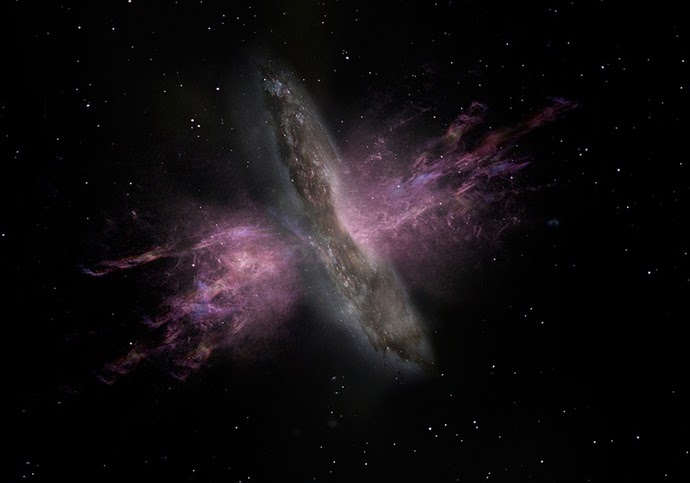
Outflows of gas driven can be driven by star formation or growing supermassive black holes (i.e., Active Galactic Nuclei; AGN) are a key component of our current models of galaxy formation. Star-formation self regulates itself through outflows, driving away the material that could form future stars. AGN are expected to drive material away by injecting mechanical and/or radiative energy into their surrounding gas. Such outflows have been detected; however, a significant challenge has been assessing their prevalence, properties and impact in galaxies over cosmic time. Crucial measurements can be made by spatially resolving the gas kinematics, using spatially-resolved spectroscopy, in order to establish the mass, energy and momentum carried by these outflows. Furthermore, as these outflows are multi-phase (i.e., ionised, atomic and molecular phases), it is necessary to use multiple observational facilities in order to establish the full physical properties.
Our group have been using large surveys to establish the prevalence and properties of star-formation and AGN-driven outflows and then using multiple observational facilities in order to establish their detailed properties. This includes work of distant galaxies (z~1-2) using KMOS, as part of the KROSS, KGES, KURVS consortia and leadership of the KASHz survey and using SINFONI as part of the SUPER survey. In the nearby Universe, Chris Harrison leads the Quasar Feedback Survey – a multi-wavelength spatially-resolved study of the most powerful nearby AGN (z~0.1).
The build up of galaxy disks over cosmis time
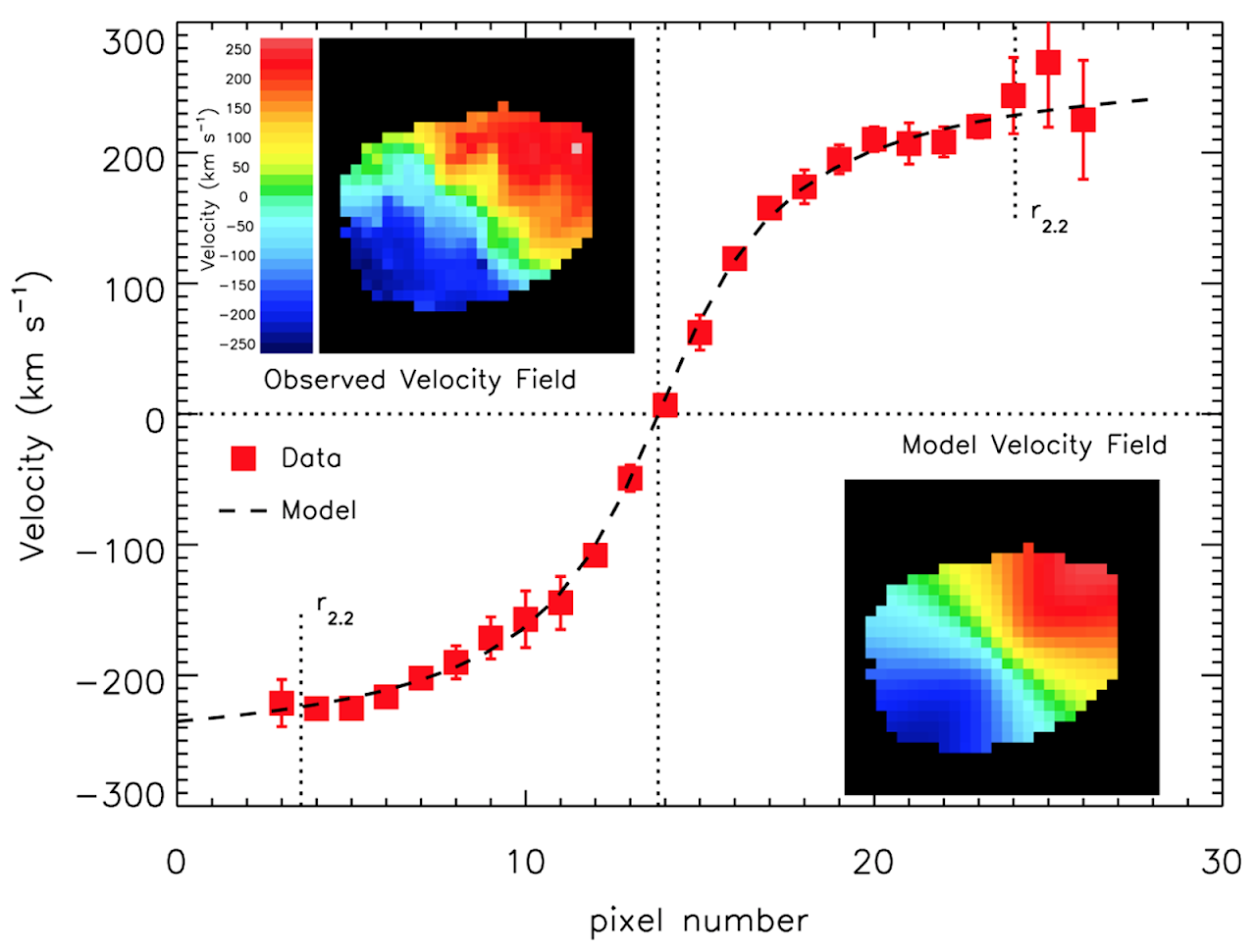
A picture is emerging in which the mode of galaxy formation in the distant Universe is very different to that in the local Universe. Rather than the quiescent formation of stars that is the norm in today’s Universe, violent episodes of star formation are dominated by the formation of super-star clusters. However, the origin of these differences is controversial: the conventional picture is that they are driven by an increase in the galaxy merger rate, but some recent theories have suggested that the difference is driven by the higher rate of gas accretion expected in the distant Universe. How then, did young galaxies, with irregular morphologies, disturbed kinematics and violent episodes of star formation evolve into the quiescent dynamically stable galaxies we see in the local Universe? Addressing this requires us to look inside galaxies by resolving the motion of the stars and gas clouds within them (to understand their structure, whether they are chaotic mergers or rotating disks) and map the distribution of new stars and metals within these galaxies.
With our collaborators, we have been designing, implementing and exploiting the largest ever spatially-resolved spectroscopic surveys of galaxies designed to investigate billions of years of galaxy evolution. This includes work of distant galaxies (z~1-2) using KMOS, as part of the KROSS, KGES, KURVS consortia
The Origin of Radio Emission in quasars
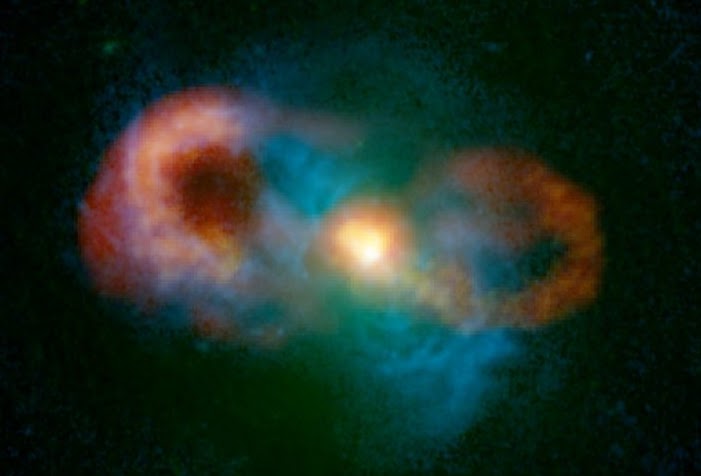
Growing supermassive black holes (Active Galactic Nuclei; AGN) are broadly split into two types based on their dominant energy output: (1) those which are radiatively [i.e., photon] dominated and (2) those which are mechanically [i.e., jets of particles] dominated. Traditionally radio emission has been used to study mechanically dominated AGN and powerful jets of charged particles have been observed in such systems for decades. However, in radiatively dominated AGN, which make up the majority of the population, the origin of the radio emission is much less clear: star formation in the host galaxy, a corona around the accretion disk, shocked winds and radio jets could all be dominating this emission. Disentangling these possibilities is important to establish the energetics of different physical processes inside these galaxies, and also to determine how black hole growth and star formation are related.
By performing deep and high spatial resolution radio observations on powerful AGN (i.e., quasars) using the VLA, eMERLIN and GMRT we are studying the relative contribution of jets, accretion disk winds/corona and star formation to producing the radio emission observed from galaxies hosting powerful AGN. This work is part of the Quasar Feedback Survey which Chris Harrison is the PI.
Star-formation in the distant Universe
Unlike nearby star-forming galaxies distant galaxies (z~1-2) are irregular and “clumpy”. Most of the star formation in the Universe occurred during this cosmic epoch. However, many questions remain about how galaxies built up their stellar mass. For example, how long-lives are star-forming “clumps” and do they form inside or outside of the galaxy that they end up in? We are working with various observational facilities, including planning for future work with the Extremely Large Telescopes, to understand star-formation in the distant Universe. More information on Chris Harrison’s website.
Preparing for the Extremely Large Telescope
Chris Harrison is part of the MOSAIC science team. MOSAIC will be the first multi-object spectrograph to be situation on the world’s biggest telescope – the Extremely Large Telescope (ELT). Chris is also part of a focus group, including people at the European Southern Observatory and INAF (Italy) to prepare the astronomical community for using HARMONI (the ELT’s integral field spectrograph)
Observational Cosmology and Large Scale Structure
Late-time cosmology with galaxy surveys
Cosmology, having long been almost exclusively a theorist’s playground, is in the midst of a data-rich age. Current cosmological galaxy surveys are able to provide locations, images and spectra of galaxies at an unprecedented volume. This means that we can use measurements of physical effects such as weak gravitational lensing, the clustering of galaxies, and the growth rate of large scale structure to pin down cosmological parameters with exquisite statistical precision. Looking to the near future, these current surveys will be joined with major flagships of the next decade which will again increase statistical power by an order of magnitude. This environment offers the chance to stress-test our standard cosmological model to a new degree, thus exploring exciting questions about the nature of dark energy, neutrino particle properties and the laws of physics at the largest scales in the Universe.
Our group is involved in major current and upcoming surveys including the ground based Dark Energy Survey (DES), the Kilo Degree Survey (KiDS), the Rubin Observatory Legacy Survey of Space and Time (LSST) and the space-based Euclid Survey due to launch its satellite in 2022. Cora Uhlemann is engaging in preparatory work for the Euclid survey, an upcoming satellite mission due to launch in 2022 , Joachim Harnois-Déraps works on the analysis of the current weak lensing Kilo Degree Survey (KiDS) and is involved with preparations for Euclid and the Rubin Observatory Legacy Survey of Space and Time (LSST), the flagship ground-based imaging survey of the 2020s, due to start observations in 2023. Dani Leonard works on data from the Dark Energy Survey, a contemporary of KiDS, and is also deeply engaged in LSST preparations.
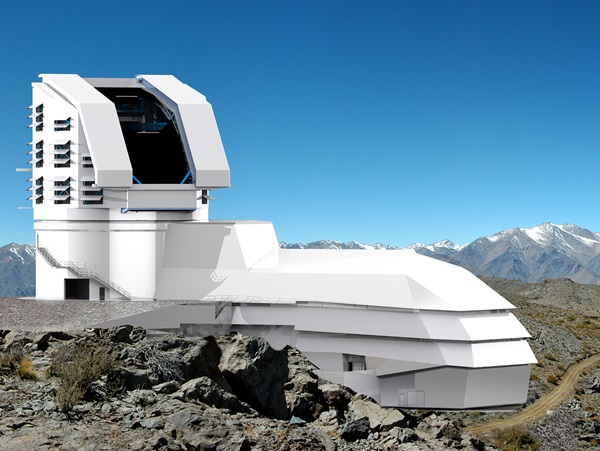
Credit: LSST Project/NSF/AURA
Refining the modelling and analysis of weak lensing and large scale structure
Going from the positions and shapes of galaxy samples to measurements of cosmological parameters or comparisons of cosmological models requires a choice of summary statistics and the precise theoretical modelling of these statistics as well as their correlations and uncertainties. In our group we approach this general problem in a number of ways:
Cora Uhlemann and Joachim Harnois-Déraps both investigate how alternative summary statistics for the matter distribution, such as the PDF (probability density function) and peak statistics, can contribute to analyses.
Joachim Harnois-Déraps creates realistic mock galaxy catalogues which can be used to test the validity of analysis pipelines and to estimate data covariances. Dani Leonard is also involved in related efforts to create mock galaxy catalogues with specific realistic features via machine learning techniques, through collaboration with the CDT in Big Data and Cloud Computing.
Dani Leonard studies how the intrinsic alignment of galaxies can contaminate measurements of shape correlations due to weak lensing, and how to best measure and mitigate this effect. Joachim Harnois-Déraps is also involved in efforts to include realistic alignments in mock galaxy catalogues.
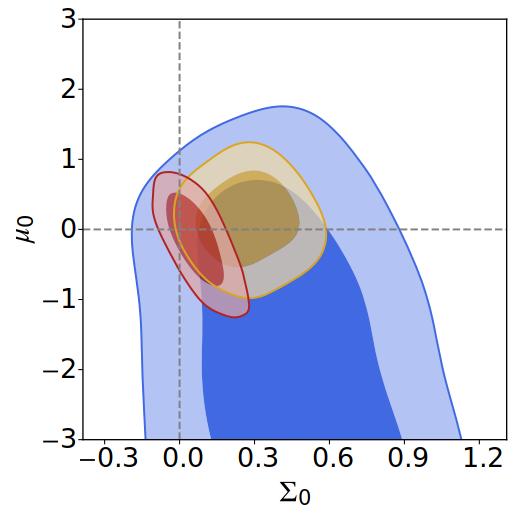
Cosmology beyond the standard paradigm
Our standard cosmological model of λ-CDM has, in the past two decades, provided excellent fits to cosmological observations such as of the cosmic microwave background, with only six free parameters. Despite this observational success, there are a number of reasons to question the ubiquity of λ-CDM, ranging from the inclusion of the two poorly-understood components of dark matter and dark energy and nonzero neutrino masses, to recent tensions in the measured value of the Hubble parameter across late and early Universe measurements.
Using the refined modelling of weak lensing and galaxy clustering, Our group’s research explores the possibility of cosmological models beyond λ-CDM in a number of directions. Cora Uhlemann’s work includes theoretical studies of fuzzy dark matter as well as evaluating the effectiveness of large-scale structure statistics in tests of gravity, while Dani Leonard’s research includes constraints on alternative theories of gravity from current cosmological galaxy survey the Dark Energy Survey, and preparatory work for future such analyses with data from the Rubin Observatory’s Legacy Survey of Space and Time.

Stellar Astrophysics: Asteroseismology, Spectroscopy and Binarity
Asteroseismology is the study of oscillations inside stars, which telescopes capture as changes in their surface brightness. The detection of stellar oscillation frequencies allows us to probe the physics of stellar structure and evolution, with the ultimate goal of asteroseismology being to improve our understanding of the interior physical conditions and processes for a diverse range of stars. The quality of space observations, such as from the CoRoT, Kepler/K2 and TESS space telescopes, provide an excellent opportunity to study physics that is not currently well understood for massive stars.
Further reading:
- Bowman (2020, Fron. Space Sci. Astron., 7, 70), ‘Asteroseismology of high-mass stars: new insights of stellar interiors with space telescopes
- Burssens, Bowman, et al. (2023, Nature Astronomy 7, 913-930), ‘A calibration point for stellar evolution from massive star asteroseismology’
- Bowman et al. (2019, Nature Astronomy 3, 760-765), ‘Low-frequency gravity waves in blue supergiants revealed by high-precision space photometry’
Dominic Bowman currently holds a UKRI Frontier Research grant, SYMPHONY, to use asteroseismology to understand the interior rotation, mixing and transport processes inside evolved massive stars known as Blue Supergiants. Complementary constraints on magnetism, multiplicity and wind physics are also accessible using photometric, spectroscopic and spectropolarimetric techniques, with Dominic and his team taking leading roles in assembling the next generation of surveys. In particular eclipsing binary stars act as fundamental laboratories in the Universe by providing model-independent dynamical masses and radii through the application of Kepler’s laws of motion. Within Dominic’s Royal Society URF grant, his team is compiling and studying a large sample of eclipsing binaries containing massive stars, which act as important benchmark systems for improving stellar structure and evolution theory.
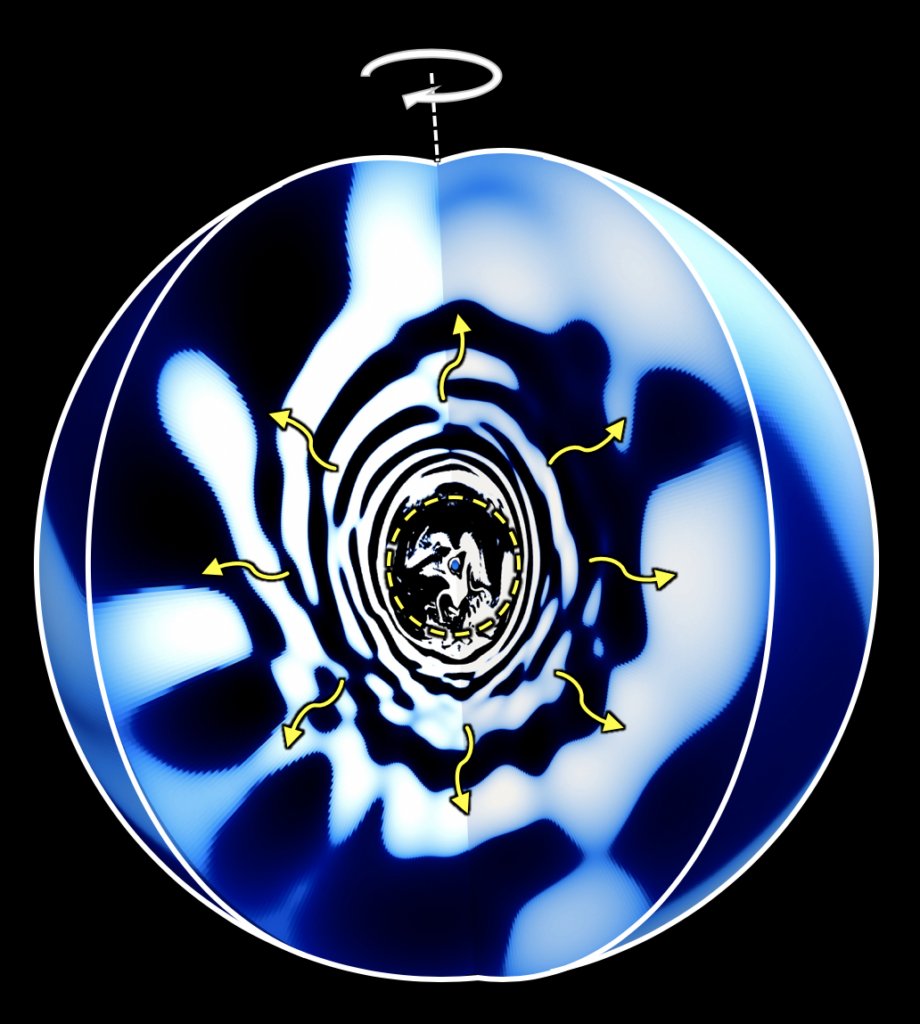
Data Sonification
Chris Harrison is part of a small, but growing community, exploring how we can use data sonification (i.e., turning data into sound) in astronomy for the purposes of: (1) making astronomy more accessible and (2) gaining a deeper understanding of the data. In 2019 he created an astronomy show using sounds and tactile models only. He leads the Audio Universe project in collaboration with James Trayford. This involves developing new sonification software for research, education and outreach. For example we created the Award-winning Audio Universe: Tour of the Solar System show in 2021, which represents the objects in the Universe with sound as well as the traditional visuals. We are working with schools and education experts to make resources that are fully accessible to the blind and vision impaired. He also meets every couple of months with the leaders of international projects such as astronify, iDATA and StarSound/VoxMagellan. Chris is leading efforts to bring together these communities by running a Lorentz Centre workshop and writing a review (accepted in Nature Astronomy).
